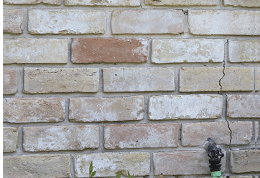
Luckily, there are TWO silver linings in this missing rain cloud.
First, there’s still plenty of time to prepare for the worst and there are practical steps you can take now to protect your home. Second, even if signs of drought damage are starting to show up, they’re relatively easy to recognize and a few simple repairs are often all you need to prevent things from getting worse and more expensive.
This is your house in a drought
Most people expect to see lawns and gardens turning brown during a drought, but as the soil beneath your house starts to harden and shift there can be problems above ground as well. The trouble begins when a receding water table causes the ground to sink or pull away from your foundation. This can cause parts of the foundation to twist or collapse, leading to more serious (and costly) kinds of structural damage over time.
Early signs of drought damage
Cracks are usually the first warning that drought could be harming your foundation. Here are some of the most common places they’ll show up:
- Radiating out from the corners of windows and doors
- Along caulked surfaces or in drywall and plaster
- As a stairstep outline along concrete blocks
- In siding, brickwork or ground level flooring
- As gaps around cabinets, baseboards or exterior trim
- On exposed areas where the foundation meets exterior walls
A few superficial cracks happen normally as new building materials settle or cure, but if you’re seeing more than one of these symptoms or a recent change, it’s a good idea to have a qualified inspector give you an opinion. In general, slab on grade foundations are more resistant to drought damage than homes with basements, but they’re still at risk when soil starts to sink.
If foundation cracks are lengthening or widening, or if the surfaces on either side of the crack aren’t on the same plane when you run your fingers over them, it’s possible that your foundation is experiencing problems. Look for areas where soil or concrete may be pulling away from the foundation. Inside the house, doors and windows may be sticking or hardware may not line up.
Preventing drought damage
Its as simple as this – taking a few precautions now can save you from costly repairs later. In addition to structural damage in the house itself, shifting soil left unchecked can separate sewers, utility mains or eventually lead to failure of the entire foundation.
- Check interior and exterior surfaces regularly for cracks and note any changes
- Inspect the perimeter for new gaps around your home’s foundation
- Install a watering system around your foundation to keep the soil moist and in place
That last one might sound crazy, but it’s important. Most people don’t think about “watering” their foundation like they do the lawn or garden, but keeping moisture properly balanced around your foundation is critical during a drought.
This can be as easy as a “D.I.Y.” soaker hose on a timer, but there are also affordable commercial solutions available you can set and forget. Keep in mind that too much moisture is as damaging as too little. If you’re tracking mud around the perimeter of your foundation, you’re over-watering.
Cautions to keep in mind
If you suspect that the drought has pulled too much moisture away from your foundation, make sure to have a professional take a look and show them what you’ve found. Until you know for sure that there’s no structural damage, hold off on cosmetic repairs like window or door replacements, drywall or carpentry repairs, or exterior grouting so you don’t end up spending that money twice. A little vigilance and some quick action will keep your home in top shape this summer.
